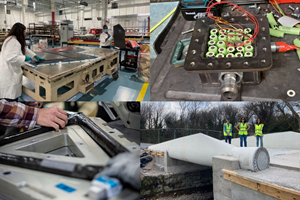Sitting on the cusp of a paradigm shift
My wife and I had to fly to New Jersey recently. As we boarded the plane and took our seats, I pointed out the window at the wing of the jet we were on and said something about how, soon, the wing and much of the fuselage of planes like this would be made from carbon fiber composites.
My wife and I had to fly to New Jersey recently. As we boarded the plane and took our seats, I pointed out the window at the wing of the jet we were on and said something about how, soon, the wing and much of the fuselage of planes like this would be made from carbon fiber composites. My wife nodded sagely, gazed out the window and said, “Is it safe?”
Of course, I quickly launched into a 10-minute tutorial on the history of metals and composites use on aircraft, about how aluminum has dominated aircraft manufacturing for so long and how carefully companies such as Boeing and Airbus have switched to composites. I explained that aircraft manufacturers place a premium on material integrity and testing and that the survival of Boeing and Airbus depends entirely on their ability to help their customers safely move people and freight from point A to point B — that the emphasis on composites is not a trivial one.
The problem with this discourse is that it almost completely understates the quantity and quality of change composites have wrought in the commercial aircraft industry. My college biology professor would call it a paradigm shift. Indeed, that so much of the newest planes (787, A350) will be comprised of composites is a testament to years of slow, gradual, careful, thoughtful and always painstaking evolution from an “old-line” tried-and- trusted material (aluminum) to a next-generation material (composites). Looking back, it all seems nearly impossible.
How hard was it to imagine even a decade ago that Boeing and Airbus would make the titanic strategic shift required to move away from aluminum and integrate composites so thoroughly into new construction? How hard was it to imagine that, one day, composites would comprise more than 50 percent of a plane’s weight, as is the case with the 787 and the A350? Then again, perhaps it was inevitable. As composite materials and manufacturing methods advanced, so did jet fuel prices and the cost of traditional raw materials; economics certainly have played a big part in the migration toward composites.
If there is any lingering doubt, however, about the future of carbon fiber in aerospace, it was surely put to rest in early February when Toray Industries Inc. announced a $451.7 million, two-year expansion of its global PAN-based carbon fiber production to meet increased demand from aircraft manufacturers. This was followed by a similar announcement from Cytec Industries Inc. that it would invest $150 million through 2010 to expand its aerospace-grade carbon fiber production. In many ways, this is the strongest signal from the market that the current wave of expansion is not just another temporary upswing in the historically up/down carbon market. It’s not without some hesitation that carbon fiber suppliers make the investment and effort to expand capacity. Carbon fiber supplies have been notoriously tight for some time, but it wasn’t until Airbus and Boeing made their commitment to composites-heavy manufacturing that these supplier expansions were solidified. Thus, the suppliers at the very bottom of the carbon fiber food chain have clearly signaled that they not only see carbon fiber’s expansion as viable, but they are willing to put money on it.
Related Content
Up, not out: The next chapter of CompositesWorld
I have been editor-in-chief of CompositesWorld for 17 years, which translates into a lot of editorials. This will be my last as I become publisher of CW. We welcome Scott Francis back to the brand to take my place.
Read MoreThe future of carbon fiber manufacture
Later this month, CW’s 25th anniversary Carbon Fiber Conference promises to be among the most important as dynamic market forces are putting unusual pressure on the carbon fiber supply chain.
Read MoreReading the Boeing tea leaves
Boeing CEO David Calhoun says not to expect a new aircraft before 2035. What are aerocomposites fabricators supposed to make of that?
Read MoreAs 2023 begins, a look back at trending CW topics in 2022
With 2022 now behind us, CW’s editor-in-chief Jeff Sloan takes a look at the CW stories last year that received the most reader attention.
Read MoreRead Next
From the CW Archives: The tale of the thermoplastic cryotank
In 2006, guest columnist Bob Hartunian related the story of his efforts two decades prior, while at McDonnell Douglas, to develop a thermoplastic composite crytank for hydrogen storage. He learned a lot of lessons.
Read MoreComposites end markets: Energy (2024)
Composites are used widely in oil/gas, wind and other renewable energy applications. Despite market challenges, growth potential and innovation for composites continue.
Read MoreCW’s 2024 Top Shops survey offers new approach to benchmarking
Respondents that complete the survey by April 30, 2024, have the chance to be recognized as an honoree.
Read More


























